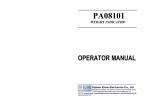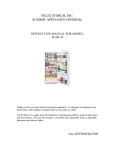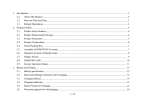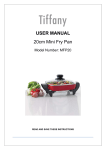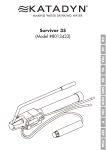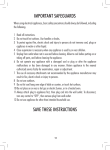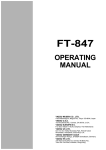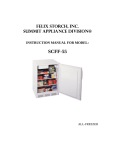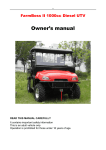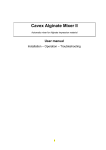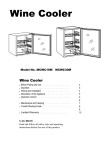Download Instruction Manual
Transcript
Instruction Manual Model No:AFR -115C MADE IN CHINA Page 1 of 7 Dear customer: Thank you for buying your new fridge. To ensure that you get the best results from your new fridge, please take time to read through these simple instructions in this booklet. Please ensure that the packaging material is disposed of in accordance with the current environmental requirements. If the fridge is visibly damaged, do not connect it to the power supply, Contact the store from where you purchased the appliance. CONTENTS WARNINGS AND IMPORTANT INFORMATION.…………………………………………………………3 INSTALLATION………………………………………………………………………………………………4 OPERATION AND MAINTENANCE……………………………………………………………………… .4 TROUBLESHOOTING………………………………………………………………...……………………..6 HOW TO DISPOSE OF THE PACKING MATERIAL……………………………………………………….7 To ensure proper use of this refrigerator and your safety, please read the following instructions completely before operating this appliance. Page 2 of 7 WARNINGS AND IMPORTANT INFORMATION Always keep this instruction booklet together with the appliance for future consultation. In the event of resale of the appliance or change of ownership, ensure that the instruction booklet is supplied with the appliance so that new owner is fully aware of all instructions and warnings present in this document. These warnings have been drawn up to ensure the safety of the user and others. Therefore read all instructions carefully prior to appliance installation and use. 1. Disconnect the mains plug before carrying out any cleaning or maintenance operations (e.g. bulb replacement). 2. This appliance has been designed to be used exclusively by adults. Ensure that children do not play near or with the appliance. 3. All modifications to the electrical mains to enable appliance installation must be carried out by a qualified technician. 4. Do not use an extension cord. On completion of installation, check that the appliance is not standing on the power cable. 5. Domestic refrigerators and/or freezers are designed exclusively to store and/or freeze foodstuffs. 6. During normal operation, the condenser and compressor, located at the rear of the appliance can reach high temperatures. Ensure that installation is carried out according to the instructions contained in this booklet. Insufficient ventilation will impair operation and damage the appliance. Never cover or obstruct the ventilation slats on the appliance. 7. Never allow children to play with the appliance. Children must never be allowed to sit on the drawers or hang on the appliance doors. 8. If the appliance is transported in a horizontal position, the oil in the compressor may flow into the refrigerant circuit. 9. Leave the appliance standing vertically for at least two hours before switching it on, to ensure that oil flows back into the compressor. 10. All refrigerators and freezers have surfaces that are subject to the formation of frost. 11. Depending on the model, this frost can be removed automatically. (automatic defrosting) or manually when necessary. Never attempt to remove frost with sharp objects as this may damage the evaporator and impair efficient appliance operation. Let the frost thaw naturally; never use hot water. 12. Never put sparkling drinks or bottles of water in the low temperature compartments (freezer/cooler) as they can explode. 13. We strongly advise against putting hot liquids or food in the refrigerator or filling ridded containers to the maximum capacity. 14. Never carry out any modifications to your appliance. 15. Never attempt to repair the appliance alone. Repairs carried out by unqualified persons can cause serious damage; always contact your nearest Service Center and use original spare parts only. 16. The refrigerant and insulation in this appliance do not contain any gases harmful to the ozone or which contribute to the greenhouse effect. However, disposal must be carried out in compliance with the relative standards regarding protection of the environment. 17. Never use the base, drawers, doors etc. to stand on or as supports. Caution: Please keep the products away from the fire or similar glowing substance before you dispose the refrigerator. Danger: Before you throw away your old refrigerator or freezer: Take off the doors. Leave the shelves in place so that children may not easily climb inside. Warning: If the supply cord is damaged, it must be replaced by the manufacturer or its service agent or a Page 3 of 7 similarly qualified person in order to avoid a hazard. Warning: This appliance can not be used in camping. Warning: This appliance can not be used in public transportations. Attention: This appliance is not intended for use by persons(including children)with reduced physical, sensory or mental capabilities, or lack of experience and knowledge, unless they have been given supervision or instruction concerning use of the appliance by a person responsible for their safety. Children should be supervised to ensure that they do not play with the appliance. INSTALLATION Positioning Position the appliance away from heat sources such as stoves, radiators, direct sunlight etc. Before connect the power supply, remove the supporting base and then screw down the front foot of appliance correctly to make it leveled correctly. This appliance is suitable in ‘T’ climate. Climate Class T Ambient Temperature From +16℃ to +43℃ Appliances must not be exposed to rain. Sufficient air must be allowed to circulate in the lower rear section of appliances, as poor air circulation can affect performance. Built-in appliances should be positioned away from heat sources such as heaters and radiators and out of direct sunlight. Behind the appliance there should be a free space of at least 3in. Kitchen units (e.g. cupboards) should be at least 2in. away from the appliance in order to assure adequate ventilation. There should be 4in. between both sides of the appliance and other obstacles. Electrical connection Before connecting the appliance to the power supply, ensure that the voltage and frequency as indicated on the data plate correspond to those of the electrical mains. A deviation of -6% to +6% is admissible with respect to the rated voltage. For operation with other voltage supplies, an adequately powered auto-transformer is required. Always connect the appliance to an efficient earthing system. Put the appliance in upright position for at least 2 hours before switching it on. OPERATION AND MAINTENANCE ① ② ③ ④ ⑤ ⑥ ⑦ ⑧ ⑨ Chiller Compartment Fridge Drip Tray Removable shelves Temperature Control Knob Bottle Racks Crisper Cover Crisper Ice Box Page 4 of 7 Operation - Temperature regulation To switch on the appliance, turn the thermostat knob clockwise from “OFF” or “0” to the required cooling temperature. An intermediate thermostat setting is generally recommended. Storing food and drink For optimal use of the refrigerator compartment observe the following instructions: 1. Never put hot liquids or food in the refrigerator; 2. Cover or wrap food prior to storage 3. Arrange food so that air can circulate freely inside the compartment. Meat (all types): Wrap in protective material and store time should be less than two days Cooked food, cold meals etc. must be covered well and stored in proper position in the refrigerator. Fruit and vegetables should be cleaned and stored in the relative drawer. Bananas, potatoes, onions and garlic should not be stored in the refrigerator unless wrapped first. Storing frozen food/freezing fresh food Appliances with compartments can be used to store frozen food for a maximum time of one month. 1. The interval between purchase and placing the food in the freezer should be as short as possible. 2. Never exceed the storage period indicated on the food packaging. 3. Only open the freezer door when necessary and as quick as possible. In the event of operation after prolonged periods of disuse, switch on the appliance under no-load conditions for 2-3 hours taking care to set the thermostat knob to the highest setting, then place food in the refrigerator as required and adjust the thermostat knob to an intermediate setting. IMPORTANT If food stored in the compartment is defrosted, e.g. due to a power failure, it should be consumed within a short time, even if not completely thawed. Ice The appliance is supplied with an ice tray to make ice. If the ice tray freezes onto the compartment, never use metal and/or sharp objects to detach the tray from the compartment. The care required for best performance, such as 1) Loadings in the refrigerating appliance should not exceed its storage volume. If the refrigerating appliance stopped for a long time (due to interruption of power supply or failure of the refrigerating system), the frozen food (fresh food) had better to be disposed of according to user’s need. 2) It is better to arrange the food when storage, to avoid cross-contamination. 3) Some types of fresh vegetables and fruits are sensitive to cold; therefore they are not suitable for storage in chill compartment. Defrosting food For optimal cooking results with frozen food, we recommend defrosting inside the refrigerator or at ambient temperature, the latter obviously required less time. If you need to save time and cook food in the shortest time, you can cook small items directly from frozen by lengthening the cooking time slightly, or put the big size items in a microwave oven to reduce the defrosting time. Defrosting the appliance Frost on the inner cooling walls of the refrigerator is eliminated automatically every time the motor Page 5 of 7 compressor is shut down. Water from melted frost is collected by means of a water tray installed underneath the evaporator at the upside of the unit. Periodically spill the defrost water in the water tray. Frost should be removed from the freezer compartment once it reaches a thickness of over 3-4 mm. Never use metal objects to remove the ice as it could damage the appliance. Refrigerator Lamp The central section of the thermostat box is fitted with a lamp for internal lighting. If replacement is required, disconnect the appliance from the power supply, remove the protection grille from the thermostat unit and unscrew the lamp. Replace with a lamp (10W max.) of the same voltage; refit the grille on the thermostat unit to complete the replacement. Prolonged periods of disuse If you do not intend to use the appliance for long periods of time. Set the thermostat knob to the “OFF” or “0” position and disconnect the power supply. Then take out the foods, defrost and clean the appliance. Leave the door slightly open. Cleaning the Appliance Disconnect the power supply before cleaning the appliance. Do not use coarse or aggressive cleaning agents as you may damage the surface. Clean the exterior with cloth. Remove the detachable accessories in the interior of the appliance and clean with water and liquid detergent. Plastic parts cannot be washed in dishwashers. Wash the interior of the appliance with wet cloth, adding one or two spoonfuls of vinegar. After cleaning, connect the appliance to power supply and reload it. TROUBLESHOOTING Defective operation of the appliance is not always due to a technical fault but is often caused by incorrect installation or use. To avoid unnecessary technical assistance and relative expenses we recommend the following procedures. 1. Internal temperature is not cool enough Check: - make sure that the door closes properly; - make sure that the thermostat setting is correct; - make sure that the refrigerator is not positioned close to heat sources; - make sure that air can circulate freely at the rear of the appliance; - make sure that the condenser is not blocked. 2. Internal temperature is too low Check: -make sure that the thermostat setting is correct. 3. Excessive appliance noise level Check: - Make sure that the appliance is leveled correctly. 4. Appliance operation failure Check: -make sure that the thermostat is not set to “OFF” or “0”; -make sure that the power supply is not disconnected; -make sure that the plug is inserted correctly into the mains socket; Page 6 of 7 -make sure that the automatic cut-out on the mains line has not tripped or that the fuse has not broken -make sure that the power cable is not faulty. NOTE If the power cable need to be replaced, remove the plug from the power socket and install the new cable, which must be requested from the Service Center and installed by a qualified technician; ensure that it is properly connected and fixed. If problems persist after the above procedures, contact your nearest Technical Assistance department. HOW TO DISPOSE OF THE PACKING MATERIAL The packing material is recyclable. The following procedure is recommended: - dispose of paper, card and carton in the relative containers; - dispose of plastics in the relative containers. - If you have no recycling bins in your area then you can put this material in the ordinary bins and/or take it to the appropriate collection centers. Page 7 of 7







